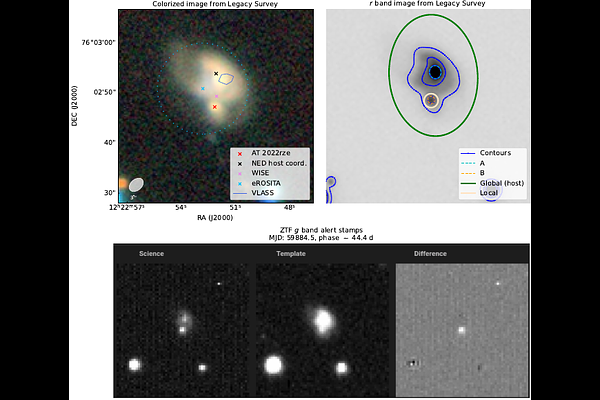The ambiguous AT2022rze: Changing-look AGN mimicking a supernova in a merging galaxy system

The ambiguous AT2022rze: Changing-look AGN mimicking a supernova in a merging galaxy system
P. J. Pessi, R. Lunnan, J. Sollerman, L. Yan, A. Le Reste, Y. Yao, S. Nordblom, Y. Sharma, M. Gilfanov, R. Sunyaev, S. Schulze, J. Johansson, A. Gangopadhyay, K. Tristram, M. Hayes, C. Fransson, Y. Hu, S. J. Brennan, S. Rose, K. De, P. Charalampopoulos, A. Gkini, M. J. Graham, C. P. Gutiérrez, S. Mattila, T. Nagao, I. Pérez-Fournon, F. Poidevin, J. S. Bloom, J. Brugger, T. X. Chen, M. M. Kasliwal, F. J. Masci, J. N. Purdum
AbstractAT2022rze is a luminous, ambiguous transient located South-East of the geometric center of its host galaxy at redshift z = 0.08. The host appears to be formed by a merging galaxy system. The observed characteristics of AT2022rze are reminiscent of active galactic nuclei (AGN), tidal disruption events (TDEs), and superluminous supernovae (SLSNe). The transient reached a peak absolute magnitude of -20.2 +- 0.2 mag, showing a sharp rise (trise,1/e = 27.5 +- 0.6 days) followed by a slow decline (tdec,1/e = 382.9 +- 0.6). Its bumpy light curve and narrow Balmer lines indicate the presence of gas (and dust). Its light curve shows rather red colors, indicating that the transient could be affected by significant host extinction. The spectra reveal coronal lines, indicative of high-energy (X-ray/UV) emission. Archival data reveal no prior activity at this location, disfavoring a steady-state AGN, although an optical spectrum obtained prior to the transient is consistent with an AGN classification of the host. Based on this, we conclude that the transient most likely represents a Changing-look AGN at the center of the smallest component of the merging system.